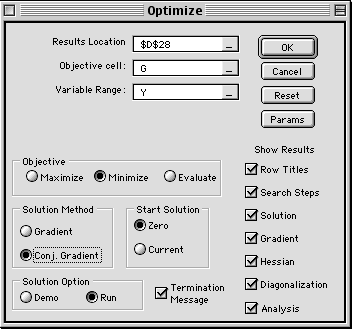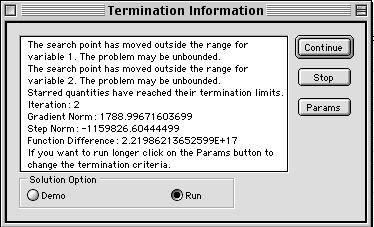|
The Congugate Gradient method uses a different procedure
to compute search directions. In most cases the number
of function evaluations to reach a stationary point
is much smaller than required for the gradient search
method. For a quadratic function, the method should
theoretically terminate after N+1 line searches, where
N is the dimension of the decision vector. In this section,
we illustrate the method as it is implemented in the
add-in. We leave the discussion of the details of the
algorithm to the textbook.
The method is initiated by clicking the Conj. Gradient
button on the Optimize dialog. We again use the G(Y)
function as an illustration.

The search results are shown below. The
process immediately moves to the negative quadrant and
the objective becomes a large negative value. We have
discovered a region of the variable space that has an
unbound objective value. The minimum found by the Gradient
method was a local minimum point. There is no global
minimum, because the objective function is unbounded
from below. The cubic terms in the function definition
cause this result.

The program recognizes the unboundedness
when the search coordinates go beyond the limits expressed
in the parameters. The termination message shows the
following.

The previously discovered local minimum
can be found by the conjugate gradient method by reducing
the maximum step size of the Golden Section line search
method. The following result was obtained by reducing
the maximum step size from 5 to 1. Note that the solution
is obtained with only four line searches and a much
smaller number of functional evaluations than required
for the gradient method.
|



